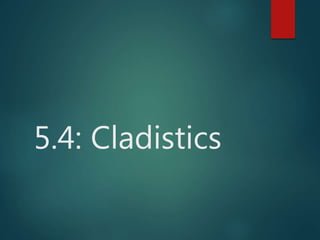
5.4 cladistics student copy
- 2. Understandings A clade is a group of organisms that have evolved from a common ancestor. Evidence for which species are part of a clade can be obtained from the base sequences of a gene or the corresponding amino acid sequence of a protein. Sequence differences accumulate gradually so there is a positive correlation between the number of differences between two species and the time since they diverged from a common ancestor. Traits can be analogous or homologous. Cladograms are tree diagrams that show the most probable sequence of divergence in clades. Evidence from cladistics has shown that classifications from some groups based on structure did not correspond with the evolutionary origins of a group or species. Applications and Skills A: Cladograms including humans and other primates. A: Reclassification of the figwort family using evidence from cladistics. S: Analysis of cladograms to deduce evolutionary relationships.
- 3. Cladistics (From the ancient Greek for "branch") is a method of classifying species of organisms into groups called clades, which consist of an ancestor organism and all its descendants (and nothing else).
- 5. Organisms are classified according to physical, cellular, and biochemical evidence http://thesis2010.micadesign.org/kropp/images/research/bird_icon.png http://www2.le.ac.uk/departments/genetics/vgec/diagrams/21%20Gene%20u nravelled.jpg/image_preview
- 6. Primitive Traits Same structure and function Developed earlier on in organisms being studied http://i.dailymail.co.uk/i/pix/2011/07/25/article-2018391-0D24AE9B00000578- 470_634x533.jpg
- 7. Derived Traits Developed more recently as a modification of a previous trait http://phenomena.nationalgeographic.com/files/2013/01/Human_chimp-brain.jpg
- 8. Homologous structures are inherited from a common ancestor
- 9. Analogous structures have similar form and function due to convergent evolution, they do not stem from a common ancestor
- 10. Biochemical Evidence Comparing DNA sequences and protein structures http://www.qm.qld.gov.au/Find+out+about/Behind+the+Scenes/Molecular+identities+lab/~/media/Images/Find%20 out%20about/Behind%20the%20scenes/Molecular%20identities%20lab/Genetic%20labs/dna-and-species- id.jpg?w=375&h=123&as=1
- 11. An evolutionary clock involves calculating the time since species diverged by comparing the number of differences in their DNA and/or protein sequences. Scientists who originated the idea calibrated the amino acid differences in haemoglobin with times derived from the fossil record. http://victorygirlsblog.com/wp-content/uploads/2015/09/clock1.jpg
- 12. The assumption is that these changes occur at a regular rate. (which may not always be the case) Therefore if species A had 5 differences from species B and 10 differences from species C, then the lineages for A and C must have split twice as long ago as for A and B C B A Time
- 13. Characteristics change over time, thus the amount of change can help determine relationships Groups of organisms are descended from a common ancestor There is a branching pattern in the evolution of species and when a split occurs, two distinct species eventuate.
- 14. TOK Read this article: Closer to man than ape What reasons are given for including chimps in genus Homo? Do you think humans will ever be reclassified Pan?
- 15. Vertebrate Hair Shelled eggs Amniotic Egg Four Limbs Bony Skeleton Each clade is determined by common characteristics of its members that are different from that of the other species from which it has diverged These traits which tie the clades together are called shared derived characters
- 16. • These two cladograms are identical (although they don’t look it) • The shape and the order of the terminal nodes does not matter. • The only information to be gathered from the cladograms below is the order of nesting of sister clades and the relative relatedness of species http://commons.wikimedia.org/wiki/File:Identical_cladograms.s
- 17. Human HumanChimp ChimpGorilla Gorilla Root Terminal nodes Sister clades: have a common ancestor Out group: Defines the ancestral characters Nodes: Common ancestors
- 19. Characters Shark Frog Kangaroo Human Vertebrae X X X X Two pairs of limbs X X X Mammary glands X X Placenta X 1) Compile a table of the characters being compared Modified from: http://www.bu.edu/gk12/eric/cladogram.pd
- 20. Vertebrae: Shark Two Pairs of Limbs: Frog Mammary Glands: Kangaroo Placenta: Human 2) Use the data to construct a Venn diagram, Start with the characteristic shared by all taxa in the biggest circle and work inwards
- 21. Shark Frog Kangaroo Human Mammary Glands Lungs Vertebrae Placenta 3) Convert the Venn diagram into a cladogram
- 22. Characters Sponge Jellyfish Flatworm Earth- worm Snail Fruit fly Starfish Human Cells with flagella X X X X X X X X Symmetry X X X X X X X Bilateral symmetry X X X X X X Mesoderm X X X X X Head develops first X X X Anus develops first X X Segmented body X X Calcified shell X Chitinous Exoskeleton X Water Vascular system X Vertebrae X Now you try! Make a Venn diagram for this data.
- 23. 1 2 3 DCBA Of the three nodes, 3 is most recent and 1 occurred earliest. Node 3 is the most recent common ancestor for C and D Node 2 is the most recent common ancestor for B and C Node 1 is the common ancestor of all taxa
- 24. Homework TOK- pg 264 Exercises 14 and 15, pg 266 See worked examples on 261 and 265 If any part is unclear, come prepared with your questions next time. Vocab Plesiomorphic traits Apomorphic traits Cladistics Clade Monophyletic group Paraphyletic group Homologous traits Analagous traits Cladogram Phylogeny